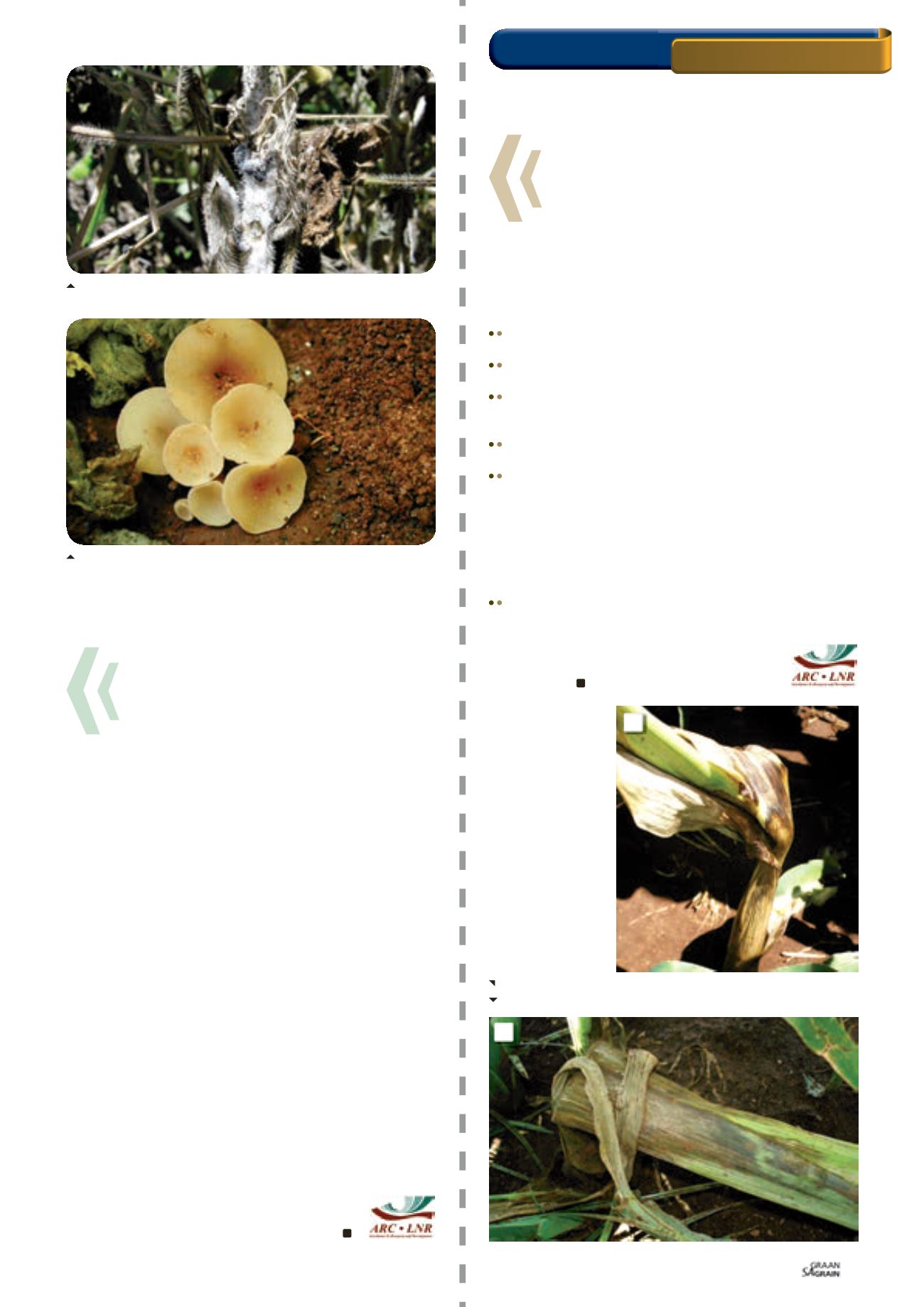
Crop rotation
Every year, a portion of the pathogen population dies because of
adverse weather conditions or the activities of other organisms.
Rotation with a non-host crop such as maize, wheat, or other grass,
will provide time for the fungal population to drop and reduce the
risk of severe disease. Crop rotation with maize or wheat reduces
levels of inoculum.
Minimum till
Deep ploughing can bury sclerotia deep enough that they can no
longer germinate and release spores. However, buried sclerotia
are known to survive longer than those left on the soil surface, and
ploughing can subsequently bring them back near the soil surface.
In contrast, minimum till and no till practices favour the natural
decline of the fungal populations in the absence of a susceptible
crop.
Biological control
Contans® WG (
Coniothyrium minitans
) is a commercial, biological
control product developed for the control of
Sclerotinia
sclerotiorum
in agricultural soils. The best and most economical
times for application are during pre-planting or post-harvest
on the stubble of a previously diseased crop, and incorporated
in the upper soil layer. Contans® WG should be applied three
months prior to soybean flowering to have the greatest impact on
parasitising sclerotia.
Chemical control
Seed treatments may be used to reduce the spread of Sclerotinia
stem rot in the field. Fungicides such as Benomyl and Thiophanate-
Methyl can provide good control of Sclerotinia if applied correctly
and properly. There are limited fungicides registered for the control
of Sclerotinia and timing is critical for successful control.
For more information on Sclerotinia stem rot on
soybeans, contact the authors at 018 299 6100 or
and
.
Sclerotinia stem rot
3: Typical large, black sclerotia develop in the stem pith.
Photo: Pannar Seed
4: Spore producing apothecia which develop on sclerotia buried in the
ground.
Photo: Pannar Seed
105
March 2014
Soos wat die siekte in die stam ontwikkel, gewoonlik vanaf een tot
drie internodes bokant die grondoppervlak, word die stam bruin,
waterig en pap (
Foto 4
). Die stam sal dan omval (
Foto 5
) met die
mielieplant se vaskulêre sisteem nog in plek.
Besmette internodes gee ‘n tipiese sterk, vrot reuk af (weer eens
soos vrot kuilvoer). Bakteriese stamvrot kan die mielieplant
vanaf enige internode van die grondoppervlak tot by die blare en
pluim affekteer. Infeksies hoër op in die plant kan pluime nadelig
beïnvloed en dus ook ‘n negatiewe uitwerking op bestuiwing hê.
Beheermaatreëls
Kies goed gedreineerde lande of verbeter dreinering om
waterakkumulasie te voorkom.
Voorkom plantbeskadiging tydens die meganiese beheer van
onkruide, bespuitings en toediening van voedingstowwe.
Vermy die oormatige vloed van lande en oorhoofse
besproeiing, veral by hoë temperature (32°C - 35°C). Besproei
eerder gedurende koeler ure in die dag.
Waar moontlik, ploeg dieper om alle plantreste goed in die
grond in te werk.
Plaaslike kultivars is nog nie getoets vir bakteriese stam-
en kelkvrotweerstand of vatbaarheid in Suid-Afrika nie.
Vanuit waarnemings en verslae is dit egter duidelik dat
daar genotipiese verskille rakende bakteriese stam- en
kelkvrotweerstand is. Dit was duidelik waar saadmielies ge-
produseer is in die Limpopo Provinsie, waar of die moeder-
of vaderlyn vatbaar was en die ander geen simptome getoon
het nie.
Tans is daar geen landbou-chemikalieë geregistreer of bekend
wat siektevlakke kan verminder nie.
Vir verdere inligting, kan dr Belinda Janse van
Rensburg of prof Bradley Flett by 018 299 6100
geskakel word.
4: ‘n Bruin, waterige, pap stam as gevolg van Erwinia.
5: Die stam val om met vaskulêre weefsel nog in plek.
5
4
Bakteriese stam- en kelkvrot
OP PLAASVLAK


